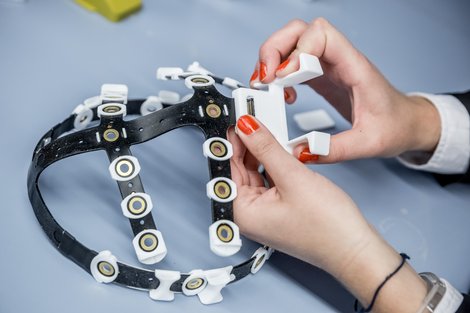Telemedical innovation - HOME2B+ “Home Monitoring of Brain and Body Functions”

Nielsen Tele Medical GmbH from Magdeburg is launching a wireless dry electrode headset on the market
EEGs are essential for the diagnosis and treatment of neurological illnesses. However, the measuring technology is time-consuming and, up to now, it has only been possible to use it in a specialist surgery or clinic. In Saxony-Anhalt, the world’s first wireless EEG headset for clinical applications is currently being prepared for market launch.
“We record up to 100 EEGs per quarter,” says Dr. Christiane Bertram. She manages a Neurology and Psychiatry practice in Schönebeck in Saxony-Anhalt. The electroencephalography, EEG for short, is a method for measuring brain waves. But according to the specialist, the EEG recorded in the doctor’s surgery is just a snapshot – and therein lies a problem. Cardiac arrhythmia, stroke or epileptic fit all trigger short-term consciousness disturbances as a symptom, among other things, but require very different treatments. “The brain waves of the patient must be measured over an extended period of time and, where possible, under the usual daily pressures,” says Christiane Bertram. However, this has been inconceivable up to now as the laborious positioning of an EEG headset has been solely down to the experienced hands of a medical technician. The approximately 20 electrodes must first be placed in a sodium-chloride solution. The scalp is prepared with an electrode paste similar to an exfoliator, so that contact is created with the electrode gel and the brain waves can be conducted and measured.
Advancement in telemedicine
In Christiane Bertram’s practice, there is now a medical engineering case, the content of which is innovative and the first of its kind in the world. The doctor is one of 18 neurologists in Saxony-Anhalt taking part in the observational study of the wireless EEG headsets. It only takes her medical technician Angelika Kellner a couple of moves to position the latest generation of electrode headset perfectly on the head. She is currently showing a patient how he can put on the cap with its integrated dry electrodes one-handed. In his hand, he holds a tablet, the remote control for the headset. Both devices are connected via a separate WLAN network. The EEG headset records the brain waves.
“The dry electrodes provide data of a high quality, even without gel or paste,” says Anne-Katrin Baum. She is the head medical technician for functional diagnostics at the hospital of the Otto-von-Guericke University Magdeburg. And she is part of the close staff team of Professor Dr. Hans-Jochen Heinze, head of the University Hospital Department of Neurology and Neurophysiology. The scientists and medics are developing this wireless electrode headset in cooperation with Nielsen. A year ago, the American information and consumer research company Nielsen founded Nielsen Tele Medical GmbH in Saxony-Anhalt. The company has its headquarters in Magdeburg’s Centre for Neuroscientific Innovation and Technology ZENIT and produces the headsets for the application test of the wireless EEG headset.
With the company, EEG measuring technology is making a leap into telemedicine. The project is called “Home Monitoring of Brain and Body Functions“, in short HOME2B+, and the wireless headset plays a central role in it. The state of Saxony-Anhalt is one of the cooperation partners. Medical engineering is a leading market here, creating innovative cutting-edge products.
From the idea to international cooperation
Hospital Director Heinze stumbled upon the idea of wireless EEG headsets when he encountered an invention in the USA: The information and consumer research company Nielsen is investigating how neuroscientists and their technology can be used in marketing there. It had developed a cap to test how consumers react to different forms of advertising.
Since then, the doctors’ surgeries that have participated in the trial, such as that of Christiane Bertram, have started to use the second, optimized headset. The doctors themselves provide significant information for its further development using anonymous forms. Anne-Katrin Baum – equipped with almost 40 years of professional experience and involved in the development of the EEG headset from the very beginning – is a competent and reliable link between the practices, the scientists and other cooperation partners. These include the health insurance funds AOK, BARMER and IKK and the Association of Statutory Health Insurance Physicians of Saxony-Anhalt.
Christiane Bertram’s patient is shown how to handle the headset. He will now take the case home with him for two days, wear the electrode headset during his normal everyday life for a number of hours and keep a diary of his activities. Then he returns it and the doctor will evaluate the brain waves saved in the headset. “Up to now, we had to admit patients to specialist hospitals for long-term observations,” says Christiane Bertram. But as society ages, the number of people requiring treatment is also increasing, meaning hospitals are already reaching the limits of their capacities and financial capabilities. In addition, the activity recorded within the network of brain cells in the quiet environment on a ward is, of course, very different to being at home.
Market introduction: 2018
As well as the opportunity to make a clear diagnosis and to provide patients with specific treatments, the doctor also sees the time saving. She explains how the 20 minutes needed to position the EEG electrodes would be reduced to five. Christiane Bertram would – like her colleagues – also use this headset in her practice. “And the aim is to equip every ambulance with it too,” adds Anne-Katrin Baum.
In 2018, the headset is expected to be launched on the international market. Anne-Katrin Baum reports about contacts at the University Hospital Magdeburg to Makerere University in Uganda’s capital of Kampala. They are also interested in telemedicine from Magdeburg there.
Author: Kathrain Graubaum (text and photo)





